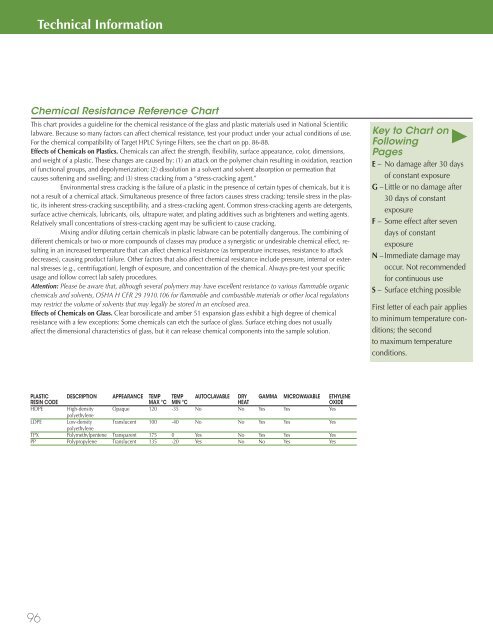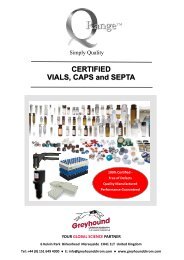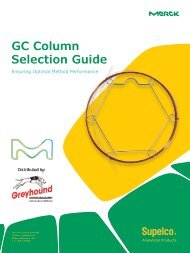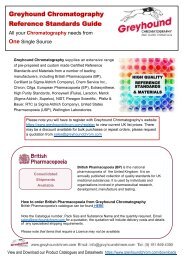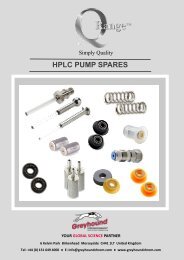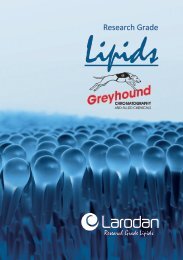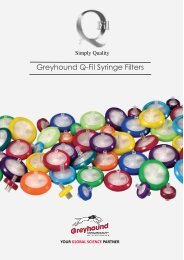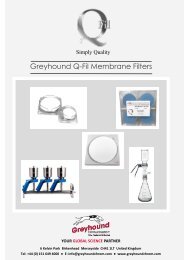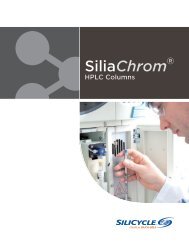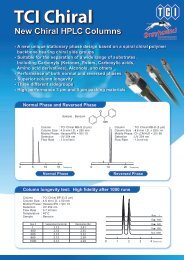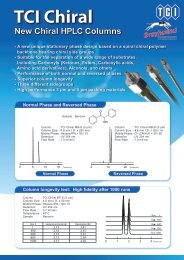National Scientific 2008-9 Catalogue
This catalogue contains product details of products from National Scientific. If you have any questions about National Scientific products or wish to discuss the pricing and delivery of products from this manufacturer, or any of the many other Manufacturers we represent, please do not hesitate to contact us either by email Sales@greyhoundchrom.com or rachel@greyhoundchrom.com (Greyhound Chromatography’s Sales Manager). We are proud of our long-standing relationships with our customers and agents. We value our agent network highly and are constantly looking to appoint new agents with the right expertise, in areas where we are not represented. Please email sales@greyhoundchrom.com if you are interested in becoming one of our agents. Visit https://www.greyhoundchrom.com for a full range of Chromatography consumables, including Certified Reference Standards and Materials, Solvents, Reagents and Laboratory Chemicals.
This catalogue contains product details of products from National Scientific. If you have any questions about National Scientific products or wish to discuss the pricing and delivery of products from this manufacturer, or any of the many other Manufacturers we represent, please do not hesitate to contact us either by email Sales@greyhoundchrom.com or rachel@greyhoundchrom.com (Greyhound Chromatography’s Sales Manager).
We are proud of our long-standing relationships with our customers and agents. We value our agent network highly and are constantly looking to appoint new agents with the right expertise, in areas where we are not represented. Please email sales@greyhoundchrom.com if you are interested in becoming one of our agents.
Visit https://www.greyhoundchrom.com for a full range of Chromatography consumables, including Certified Reference Standards and Materials, Solvents, Reagents and Laboratory Chemicals.
You also want an ePaper? Increase the reach of your titles
YUMPU automatically turns print PDFs into web optimized ePapers that Google loves.
Technical Information<br />
Chemical Resistance Reference Chart<br />
This chart provides a guideline for the chemical resistance of the glass and plastic materials used in <strong>National</strong> <strong>Scientific</strong><br />
labware. Because so many factors can affect chemical resistance, test your product under your actual conditions of use.<br />
For the chemical compatibility of Target HPLC Syringe Filters, see the chart on pp. 86-88.<br />
Effects of Chemicals on Plastics. Chemicals can affect the strength, flexibility, surface appearance, color, dimensions,<br />
and weight of a plastic. These changes are caused by: (1) an attack on the polymer chain resulting in oxidation, reaction<br />
of functional groups, and depolymerization; (2) dissolution in a solvent and solvent absorption or permeation that<br />
causes softening and swelling; and (3) stress cracking from a “stress-cracking agent.”<br />
Environmental stress cracking is the failure of a plastic in the presence of certain types of chemicals, but it is<br />
not a result of a chemical attack. Simultaneous presence of three factors causes stress cracking: tensile stress in the plastic,<br />
its inherent stress-cracking susceptibility, and a stress-cracking agent. Common stress-cracking agents are detergents,<br />
surface active chemicals, lubricants, oils, ultrapure water, and plating additives such as brighteners and wetting agents.<br />
Relatively small concentrations of stress-cracking agent may be sufficient to cause cracking.<br />
Mixing and/or diluting certain chemicals in plastic labware can be potentially dangerous. The combining of<br />
different chemicals or two or more compounds of classes may produce a synergistic or undesirable chemical effect, resulting<br />
in an increased temperature that can affect chemical resistance (as temperature increases, resistance to attack<br />
decreases), causing product failure. Other factors that also affect chemical resistance include pressure, internal or external<br />
stresses (e.g., centrifugation), length of exposure, and concentration of the chemical. Always pre-test your specific<br />
usage and follow correct lab safety procedures.<br />
Attention: Please be aware that, although several polymers may have excellent resistance to various flammable organic<br />
chemicals and solvents, OSHA H CFR 29 1910.106 for flammable and combustible materials or other local regulations<br />
may restrict the volume of solvents that may legally be stored in an enclosed area.<br />
Effects of Chemicals on Glass. Clear borosilicate and amber 51 expansion glass exhibit a high degree of chemical<br />
resistance with a few exceptions: Some chemicals can etch the surface of glass. Surface etching does not usually<br />
affect the dimensional characteristics of glass, but it can release chemical components into the sample solution.<br />
Key to Chart on<br />
Following<br />
Pages<br />
E – No damage after 30 days<br />
of constant exposure<br />
G – Little or no damage after<br />
30 days of constant<br />
exposure<br />
F – Some effect after seven<br />
days of constant<br />
exposure<br />
N – Immediate damage may<br />
occur. Not recommended<br />
for continuous use<br />
S – Surface etching possible<br />
First letter of each pair applies<br />
to minimum temperature conditions;<br />
the second<br />
to maximum temperature<br />
conditions.<br />
PLASTIC DESCRIPTION APPEARANCE TEMP TEMP AUTOCLAVABLE DRY GAMMA MICROWAVABLE ETHYLENE<br />
RESIN CODE MAX ºC MIN ºC HEAT OXIDE<br />
HDPE High-density Opaque 120 -35 No No Yes Yes Yes<br />
polyethylene<br />
LDPE Low-density Translucent 100 -40 No No Yes Yes Yes<br />
polyethylene<br />
TPX Polymethylpentene Transparent 175 0 Yes No Yes Yes Yes<br />
PP Polypropylene Translucent 135 -20 Yes No No Yes Yes<br />
96


